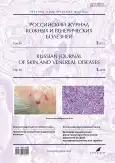Photogallery. Clinical variants of lichen planus involving the scalp
- Authors: Dubenskiy V.V.1, Nekrasova E.G.1, Aleksandrova O.A.1, Muraveva E.S.1, Bondarenko M.A.1
-
Affiliations:
- Tver State Medical University
- Issue: Vol 28, No 3 (2025)
- Pages: 357-364
- Section: PHOTO GALLERY
- URL: https://bakhtiniada.ru/1560-9588/article/view/313083
- DOI: https://doi.org/10.17816/dv646417
- EDN: https://elibrary.ru/PMXXUH
- ID: 313083
Cite item
Abstract
Lichen planus is a chronic inflammatory disorder affecting the skin and mucous membranes (less commonly the nails and hair), characterized by the presence of lichenified papules. When localized on the scalp, it manifests as a follicular variant known as lichen planopilaris, often resulting in scarring alopecia.
There are four recognized clinical variants of follicular lichen planus: classic lichen planopilaris; frontal fibrosing alopecia; Graham–Little–Piccardi–Lasseur syndrome; and fibrosing alopecia in a pattern distribution, which combines features of lichen planopilaris and androgenetic alopecia.
Despite their different presentations, all lichen planopilaris variants are characterized by one or more areas of scarring alopecia and scalp erythema. Pruritus is a common symptom and may vary in severity; trichodynia (scalp tenderness) is also frequently reported. Some patients may exhibit typical lesions of lichen planus on other skin areas or oral mucosa. In the active stage, dermoscopy of alopecic patches typically reveals perifollicular hyperkeratosis with tubular hair casts, diffuse or perifollicular erythema, and light pink-to-red fibrotic zones. The hair-pull test is positive in inflamed areas, yielding anagen hairs with intact inner root sheaths. During remission, alopecic scars may remain with a few preserved hairs and tufts (tufted hairs). Dermoscopy may show follicular ostia loss (“white dots”) and absence of inflammation.
Diagnosis is based on clinical examination and trichoscopic findings, supplemented by histopathology from an active lesion if needed. Histologically, perifollicular lymphocytic infiltrates with sebaceous gland destruction are typical. Recommended evaluations include routine laboratory tests and thyroid function screening; many authors also advocate testing for viral hepatitis.
Photographic documentation before and during treatment is advised to monitor clinical progression, alongside trichoscopy for assessment of inflammatory activity.
This photo gallery presents various clinical manifestations of follicular lichen planus of the scalp.
Full Text
##article.viewOnOriginalSite##About the authors
Valeriy V. Dubenskiy
Tver State Medical University
Email: valerydubensky@yandex.ru
ORCID iD: 0000-0002-1671-461X
SPIN-code: 3577-7335
MD, Dr. Sci. (Medicine), Professor
Russian Federation, TverElizaveta G. Nekrasova
Tver State Medical University
Author for correspondence.
Email: nekrasova-7@mail.ru
ORCID iD: 0000-0002-2805-6749
SPIN-code: 5831-5824
MD, Cand. Sci. (Medicine), Associate Professor
Russian Federation, TverOlga A. Aleksandrova
Tver State Medical University
Email: olgaalexandrova@live.com
ORCID iD: 0000-0001-8281-3619
SPIN-code: 8080-0721
Russian Federation, Tver
Ekaterina S. Muraveva
Tver State Medical University
Email: katerisha87@yandex.ru
ORCID iD: 0000-0001-5326-4876
SPIN-code: 3332-8424
Russian Federation, Tver
Maria A. Bondarenko
Tver State Medical University
Email: mari-prusova@mail.ru
ORCID iD: 0009-0002-8876-0524
Russian Federation, Tver
References
Supplementary files
















